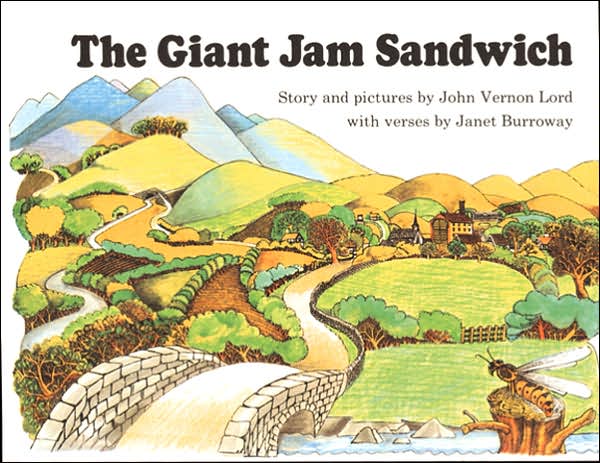

Similarly, books my mom read to us when we were kids, books I found on my own at school or in the library have a lot to do with the kinds of stories I like, the sorts of images I'm drawn to, and the way I tell stories and read to my own children now.
I was a Weekly Reader junkie and my mom allowed me to buy ridiculous numbers of books in grade school so I have a lot of memories to choose from. However, there is a core of books that I remember more than others and, as an adult, I've begun tracking them down and buying them so I can read them to my kids.
A couple are books that my Grandma Brown had at her house and were always sort of the special treat at bedtime when we went there to visit. The Giant Jam Sandwich and Something Queer Is Going On both made big impressions on me. TGJS because of its' perfect, sing-song rhyme and terrific, stylized images and SQIGO because the cleverness of the prose and pictures and the fact that it in no way talked down to its readers. (Both Maryn and Avery love the loud, dramatic reading of "You STOLE Jill's dog!")


One of my most important books was Andrew Henry's Meadow by Doris Burn. Andrew Henry is a boy who is constantly building things and, unfortunately, getting in his family's way by doing so. He builds an eagle's cage in the living room while his dad is trying to read the paper, he hooks up a homemade merry-go-round to his sisters' sewing machine when they want to work on it, etc.
So eventually, he decides to strike out on his own. He packs up a bag of tools and supplies and heads off into the deep woods. When he eventually comes to a meadow, he decides to settle and he builds himself a house out of stone and logs. The element I remember best is that he included a landing pad for the meadow dragonflies.
Anyway, other kids from the town (Stubbsville, I think) find their way to the meadow because they have weird things they like that their parents don't want around. One girl loves birds but her dad is a farmer who wants to scare them away from his crops. Another boy has a whole drawer full of dandelion parachutes that his mother wants him to throw away. They all convene in the meadow and Andrew Henry builds them each their own individualized house. (Bird girl gets a tree house with feeders and baths and a mount for her binoculars, dandelion boy gets a tower from which to launch his collection, etc.) Eventually, there are nine little houses in the meadow with the shining brook.
Soon, the townspeople notice the kids are missing and begin to search. Andrew Henry's dog, Sam, who watched AH leave, leads the town through the deep woods and the children are found. It's a happy reunion and, once Andrew moves back home, his parents give him a corner in the basement to use as his building area. Kid appreciates family more, family appreciates kid more, everyone is happy.
Describing it now, it seems like there are more serious themes at work but when I was a kid, I just really liked the ingenious pictures of the houses Andrew constructs. I also liked that, according to the author's note in the back, Doris Burn lived on an island and did all her work in a little cabin that was heated by a wood-burning stove. That seems exotic and very artistic to me back then. (Still does.)
The potentially sad note to this is that, in my search for the image below, I discovered that there are plans to make a movie out of AHM and, worst of all, the screenplay was written by Zach Braff of Scrubs and Garden State fame. I hate Zach Braff the way I hate foot fungus and kids with trust funds. The man-boy is unctuous and awful and to think that he is going to have a hand in the shaping of the movie version of this very important book makes my skin crawl. Please Braff, please, excuse yourself from this project and go pull your overly self-satisfied act somewhere else. I would rather a movie of this book never get made than be made by you.

One other book that stands large in my childhood is Miss Nelson Is Missing by Harry Allard and James Marshall. A class of disobedient, disrespectful students get a rude awakening when their teacher, the sweet, lovely, patient Miss Nelson, mysteriously disappears and is replaced by the evil, angry, exacting Miss. Viola Swamp. The pre-M. Night Shyamalan twist at the end was a thrill every time. I'm not sure about my younger brothers but I know that Jason, my mom, and I all remember Miss Viola Swamp vividly.
Consequently, you can imagine my joy when Suzanne and I came across this shirt in one of our favorite Ann Arbor stores, The Peaceable Kingdom:

Awesome.































